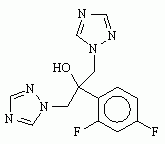Oral candidiasis (thrush) commonly occurs in healthy infants. Nystatin oral suspension is the usual treatment, but cure rates as low as 54 percent have been confirmed in clinical studies. Fluconazole, from the imidazole class of antifungals, has been found effective in treating thrush in immunocompromised children, but studies among otherwise healthy children have not been done. Goins and associates compared fluconazole and nystatin suspensions for treatment of thrush in infants using a prospective, unblinded, randomized clinical trial.
Infants from 1 to 12 months of age with clinical signs and positive microscopic confirmation of thrush who were otherwise healthy were randomly assigned to receive either nystatin suspension (1 mL four times daily to affected mucosa for 10 days) or fluconazole suspension (3 mg per kg orally once daily for seven days). Patients with a negative initial fungal culture were not included in the study.
On day 3, at the end of therapy (day 7 for the fluconazole group or day 10 for the nystatin group), and on day 28, patients were re-examined and follow-up cultures were performed. A clinical cure was considered the absence of any oral plaque at the end of therapy. A microbiologic cure was considered a negative fungal culture also obtained at this time. Clinical recurrence was defined as oral plaques confirmed to be fungal by microscopic examination on day 28.
Six of the 21 infants (28.6 percent) receiving nystatin were clinically cured after 10 days of treatment compared with all of the 15 infants (100 percent) receiving fluconazole for seven days. Microbiologic cure occurred in one of the 18 infants in the nystatin group (5.6 percent) who were cultured at the end of therapy compared with 11 of the 15 patients in the fluconazole group (73.3 percent). Recurrence rates could not be evaluated in the nystatin group because 15 of the 21 patients who failed nystatin therapy were switched to fluconazole. There were no complications of therapy in either group.
The authors conclude that administration of oral fluconazole, resulting in a high drug concentration in the oral mucosa and saliva, is significantly more effective than conventional nystatin suspension in the treatment of oral candidiasis in otherwise healthy infants. There were no adverse events noted with fluconazole use. Problems with the use of fluconazole include cost and the possibility of developing fluconazole-resistant strains of Candida albicans. Larger studies are needed to look at the cost efficiency of fluconazole treatment of thrush in infants.
COPYRIGHT 2003 American Academy of Family Physicians
COPYRIGHT 2003 Gale Group



